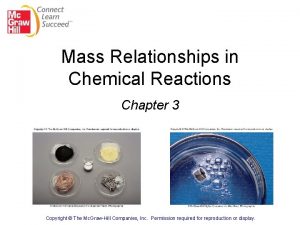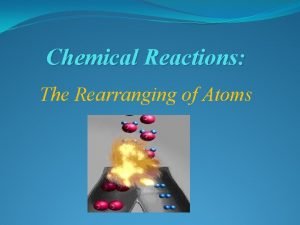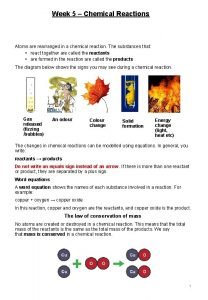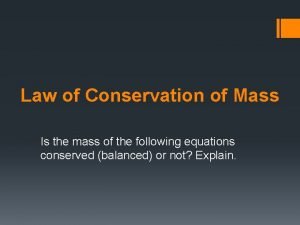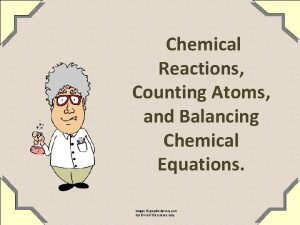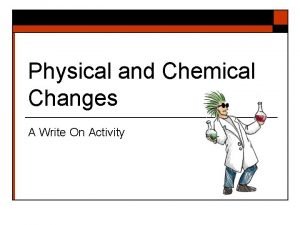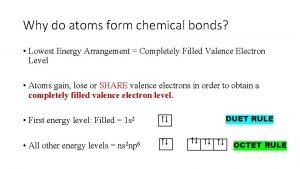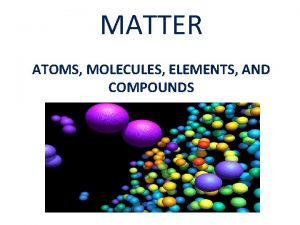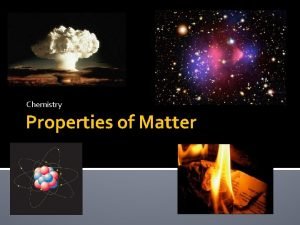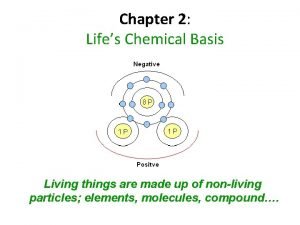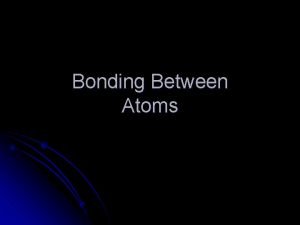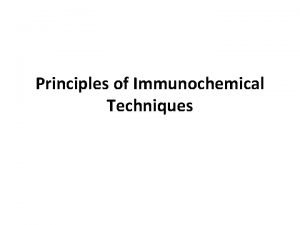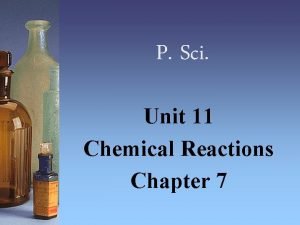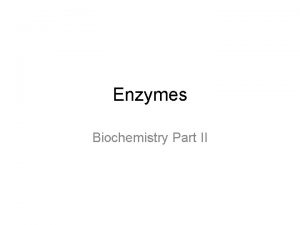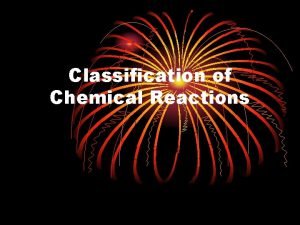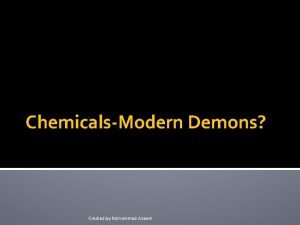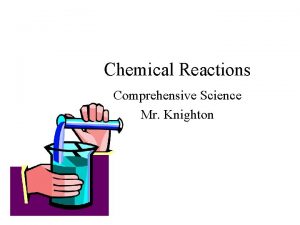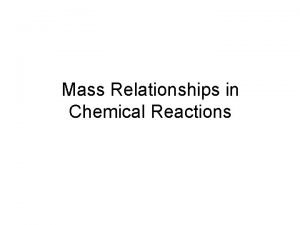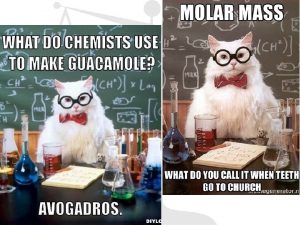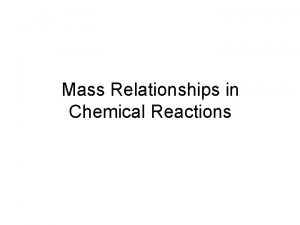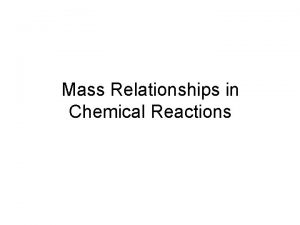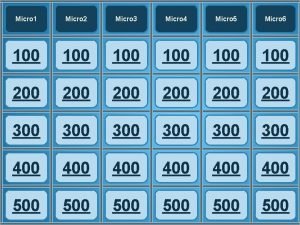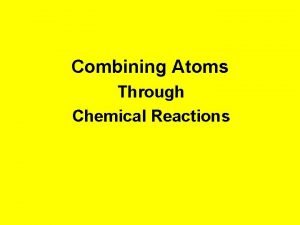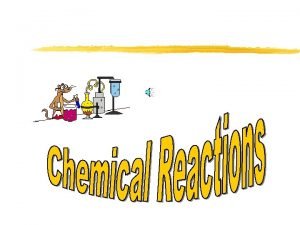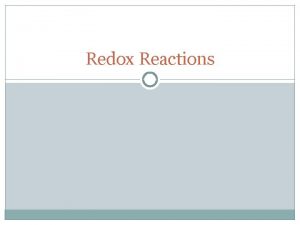Mass Relationships in Chemical Reactions Micro World atoms














































- Slides: 46

Mass Relationships in Chemical Reactions

Micro World atoms & molecules Macro World grams Atomic mass is the mass of an atom in atomic mass units (amu) amu definition: the mass exactly equal to 1/12 the mass of one 12 C atom 12 C = 6 , 6 p, 6 n =12. 00 amu me-=0 Experiment show one atom 1 H = 88. 400% of 12 C atom thus mass of one atom 1 H =1. 008 amu(12. 00 x. 08400) 16 O = 16. 00 amu , 26 Fe = 55. 85 amu 2

The average atomic mass is the weighted average of all of the naturally occurring isotopes of the element. 13 C=13. 00335 amu average atomic mass of C=(0. 9890 x 12. 00000 amu)+(0. 0110 x 13. 00335) =12. 01 amu 3

Naturally occurring lithium is: 7. 42% 6 Li (6. 015 amu) 92. 58% 7 Li (7. 016 amu) Average atomic mass of lithium: 7. 42 x 6. 015 + 92. 58 x 7. 016 = 6. 941 amu 100 4

5

Average atomic mass (6. 941) 6

The Mole (mol): A unit to count numbers of particles Dozen = 12 Pair = 2 The mole (mol) is the amount of a substance that contains as many elementary entities as there atoms in exactly 12. 00 grams of 12 C 1 mol = NA = 6. 0221367 x 1023 Avogadro’s number (NA) 7

eggs Molar mass is the mass of 1 mole of shoes in grams marbles atoms 1 mole 12 C atoms = 6. 022 x 1023 atoms = 12. 00 g 1 12 C atom = 12. 00 amu 1 mole 12 C atoms = 12. 00 g 12 C 1 mole lithium atoms = 6. 941 g of Li For any element atomic mass (amu) = molar mass (grams) 8

One Mole of: S C Hg Cu Fe 9

1 12 C atom 12. 00 g 1. 66 x 10 -24 g x = 23 12 12. 00 amu 6. 022 x 10 C atoms 1 amu = 1. 66 x 10 -24 g or 1 g = 6. 022 x 1023 amu M = molar mass in g/mol NA = Avogadro’s number 10

How many atoms are in 0. 551 g of potassium (K) ? 1 mol K = 39. 10 g K 1 mol K = 6. 022 x 1023 atoms K 1 mol K 6. 022 x 1023 atoms K 0. 551 g K x x = 1 mol K 39. 10 g K 8. 49 x 1021 atoms K 11

12

13

14

Molecular mass (or molecular weight) is the sum of the atomic masses (in amu) in a molecule. 1 S SO 2 2 O SO 2 32. 07 amu + 2 x 16. 00 amu 64. 07 amu For any molecule molecular mass (amu) = molar mass (grams) 1 molecule SO 2 = 64. 07 amu 1 mole SO 2 = 64. 07 g SO 2 15

16

How many H atoms are in 72. 5 g of C 3 H 8 O ? 1 mol C 3 H 8 O = (3 x 12) + (8 x 1) + 16 = 60 g C 3 H 8 O 1 mol C 3 H 8 O molecules = 8 mol H atoms 1 mol H = 6. 022 x 1023 atoms H 1 mol C 3 H 8 O 8 mol H atoms 6. 022 x 1023 H atoms 72. 5 g C 3 H 8 O x x x = 1 mol C 3 H 8 O 1 mol H atoms 60 g C 3 H 8 O 5. 82 x 1024 atoms H 17

18

Formula mass is the sum of the atomic masses (in amu) in a formula unit of an ionic compound. 1 Na Na. Cl 22. 99 amu 1 Cl + 35. 45 amu Na. Cl 58. 44 amu For any ionic compound formula mass (amu) = molar mass (grams) 1 formula unit Na. Cl = 58. 44 amu 1 mole Na. Cl = 58. 44 g Na. Cl 19

What is the formula mass of Ca 3(PO 4)2 ? 1 formula unit of Ca 3(PO 4)2 3 Ca 3 x 40. 08 2 P 8 O 2 x 30. 97 + 8 x 16. 00 310. 18 amu 20

Heavy Light Mass Spectrometer Mass Spectrum of Ne 21

Percent composition of an element in a compound = n x molar mass of element x 100% molar mass of compound n is the number of moles of the element in 1 mole of the compound 2 x (12. 01 g) x 100% = 52. 14% 46. 07 g 6 x (1. 008 g) %H = x 100% = 13. 13% 46. 07 g 1 x (16. 00 g) %O = x 100% = 34. 73% 46. 07 g %C = C 2 H 6 O 52. 14% + 13. 13% + 34. 73% = 100. 0% 22

23

Examples What is the mass of H , Cl in 10 g HCl? What is % composition of the elements C in CH 3 COOH? What is % composition of the elements in 25. 00 g H 2 SO 4 if m. H = 0. 5142 g and m. O = 16. 3239 g and m. S= 8. 1619 g ? 24

Percent Composition and Empirical Formulas Determine the empirical formula of a compound that has the following percent composition by mass: K 24. 75, Mn 34. 77, O 40. 51 percent. 1 mol K n. K = 24. 75 g K x = 0. 6330 mol K 39. 10 g K n. Mn = 34. 77 g Mn x 1 mol Mn = 0. 6329 mol Mn 54. 94 g Mn n. O = 40. 51 g O x 1 mol O = 2. 532 mol O 16. 00 g O 25

Percent Composition and Empirical Formulas n. K = 0. 6330, n. Mn = 0. 6329, n. O = 2. 532 0. 6330 ~ K: ~ 1. 0 0. 6329 Mn : 0. 6329 = 1. 0 0. 6329 2. 532 ~ O: ~ 4. 0 0. 6329 KMn. O 4 26

27

Combust 11. 5 g ethanol Collect 22. 0 g CO 2 and 13. 5 g H 2 O g CO 2 mol C g. C 6. 0 g C = 0. 5 mol C g H 2 O mol H g. H 1. 5 g H = 1. 5 mol H g of O = g of sample – (g of C + g of H) 4. 0 g O = 0. 25 mol O Empirical formula C 0. 5 H 1. 5 O 0. 25 Divide by smallest subscript (0. 25) Empirical formula C 2 H 6 O 28

Molecular Formulas Molecular weight of the compound should be known X= M actual Multiply the empirical formula by the integer x M empirical a compound has empirical formula C 6 H 10 S 2 O but its molecular weight is 324 g/mol C 12 H 20 S 4 O 2 Calculate the number of grams of Al in 371 g of Al 2 O 3 ? 196. 5 g 29

30

A process in which one or more substances is changed into one or more new substances is a chemical reaction A chemical equation uses chemical symbols to show what happens during a chemical reaction reactants products 3 ways of representing the reaction of H 2 with O 2 to form H 2 O 31

How to “Read” Chemical Equations 2 Mg + O 2 2 Mg. O 2 atoms Mg + 1 molecule O 2 makes 2 formula units Mg. O 2 moles Mg + 1 mole O 2 makes 2 moles Mg. O 48. 6 grams Mg + 32. 0 grams O 2 makes 80. 6 g Mg. O NOT 2 grams Mg + 1 gram O 2 makes 2 g Mg. O 32

Balancing Chemical Equations 1. Write the correct formula(s) for the reactants on the left side and the correct formula(s) for the product(s) on the right side of the equation. Ethane reacts with oxygen to form carbon dioxide and water C 2 H 6 + O 2 CO 2 + H 2 O 2. Change the numbers in front of the formulas (coefficients) to make the number of atoms of each element the same on both sides of the equation. Do not change the subscripts. 2 C 2 H 6 NOT C 4 H 12 33

Balancing Chemical Equations 3. Start by balancing those elements that appear in only one reactant and one product. C 2 H 6 + O 2 2 carbon on left C 2 H 6 + O 2 6 hydrogen on left C 2 H 6 + O 2 CO 2 + H 2 O start with C or H but not O 1 carbon on right multiply CO 2 by 2 2 CO 2 + H 2 O 2 hydrogen on right 2 CO 2 + 3 H 2 O multiply H 2 O by 3 34

Balancing Chemical Equations 4. Balance those elements that appear in two or more reactants or products. C 2 H 6 + O 2 2 oxygen on left 2 CO 2 + 3 H 2 O multiply O 2 by 7 2 4 oxygen + 3 oxygen = 7 oxygen (3 x 1) on right (2 x 2) C 2 H 6 + 7 O 2 2 2 CO 2 + 3 H 2 O 2 C 2 H 6 + 7 O 2 4 CO 2 + 6 H 2 O remove fraction multiply both sides by 2 35

Balancing Chemical Equations 5. Check to make sure that you have the same number of each type of atom on both sides of the equation. 2 C 2 H 6 + 7 O 2 4 CO 2 + 6 H 2 O 4 C (2 x 2) 4 C 12 H (2 x 6) 12 H (6 x 2) 14 O (7 x 2) 14 O (4 x 2 + 6) Reactants 4 C 12 H 14 O Products 4 C 12 H 14 O 36

Amounts of Reactants and Products 1. Write balanced chemical equation 2. Convert quantities of known substances into moles 3. Use coefficients in balanced equation to calculate the number of moles of the sought quantity 4. Convert moles of sought quantity into desired units 37

Methanol burns in air according to the equation 2 CH 3 OH + 3 O 2 2 CO 2 + 4 H 2 O If 209 g of methanol are used up in the combustion, what mass of water is produced? grams CH 3 OH moles CH 3 OH molar mass CH 3 OH 209 g CH 3 OH x moles H 2 O grams H 2 O molar mass coefficients H 2 O chemical equation 4 mol H 2 O 18. 0 g H 2 O 1 mol CH 3 OH = x x 32. 0 g CH 3 OH 1 mol H 2 O 2 mol CH 3 OH 235 g H 2 O 38

Limiting Reagent: Reactant used up first in the reaction. 2 NO + O 2 2 NO 2 NO is the limiting reagent O 2 is the excess reagent 39

In one process, 124 g of Al are reacted with 601 g of Fe 2 O 3 2 Al + Fe 2 O 3 Al 2 O 3 + 2 Fe Calculate the mass of Al 2 O 3 formed. g Al g Fe 2 O 3 124 g Al x mol Al mol Fe 2 O 3 needed OR mol Al needed mol Fe 2 O 3 1 mol Al 27. 0 g Al x g Fe 2 O 3 needed 1 mol Fe 2 O 3 2 mol Al Start with 124 g Al 160. g Fe 2 O 3 = x 1 mol Fe 2 O 3 g Al needed 367 g Fe 2 O 3 need 367 g Fe 2 O 3 Have more Fe 2 O 3 (601 g) so Al is limiting reagent 40

Use limiting reagent (Al) to calculate amount of product that can be formed. g Al mol Al 2 O 3 2 Al + Fe 2 O 3 124 g Al x 1 mol Al 27. 0 g Al x 1 mol Al 2 O 3 2 mol Al g Al 2 O 3 + 2 Fe 102. g Al 2 O 3 = x 1 mol Al 2 O 3 234 g Al 2 O 3 At this point, all the Al is consumed and Fe 2 O 3 remains in excess. 41

Another method 2 Al + 124 g 4. 596 mol 4. 599 mol Al 2. 300 Fe 2 O 3 Al 2 O 3 + 2 Fe 601 g 3. 7633 mol 3. 763 mol Al 1 mol Al 3. 763 Al is the least thus it is the limiting reagent 42

Use limiting reagent (Al) to calculate amount of product that can be formed. g Al mol Al 2 O 3 2 Al + Fe 2 O 3 124 g Al x 1 mol Al x 26. 98. 0 g Al 1 mol Al 2 O 3 2 mol Al g Al 2 O 3 + 2 Fe 102. 0 g Al 2 O 3 = 234. 4 g Al 2 O 3 x 1 mol Al 2 O 3 At this point, all the Al is consumed and Fe 2 O 3 remains in excess. 43

Reaction Yield Theoretical Yield is the amount of product that would result if all the limiting reagent reacted. Actual Yield is the amount of product actually obtained from a reaction. % Yield = Actual Yield Theoretical Yield x 100% 44

5 Ca + 1. 96 x 103 g V 2 O 5 5 Ca. O + 2 V ? g 1. 54 x 103 g Calculate % yield if 803 g of Ca. O is produced? 42. 34 mol 48. 90 mol 8. 467 mol 48. 90 mol Ca 5 mol Ca 8. 467 mol V 2 O 5 1 mol V 2 O 5 9. 78 % Yield = 2374. 2 g Ca. O 8. 467 803 g 2374. 2 g x 100 = 33. 8% 45

46
 Section 2 reinforcement classifying chemical reactions
Section 2 reinforcement classifying chemical reactions Section 2 reinforcement classifying chemical reactions
Section 2 reinforcement classifying chemical reactions Mass relationships in chemical reactions
Mass relationships in chemical reactions Rearranging chemical equations
Rearranging chemical equations In chemical reactions atoms are rearranged
In chemical reactions atoms are rearranged Types of reactions
Types of reactions Stoichiometry island diagram
Stoichiometry island diagram Chemical reactions section 1 chemical changes
Chemical reactions section 1 chemical changes Are kc and kp equal
Are kc and kp equal What is the law of conservation of mass
What is the law of conservation of mass Periodic table of elements regents
Periodic table of elements regents What are redox reactions examples
What are redox reactions examples Unit 5 chemical reactions answers
Unit 5 chemical reactions answers Co2 + h2o c6h12o6 + o2
Co2 + h2o c6h12o6 + o2 Chemical change atoms
Chemical change atoms Chemical bonds form when atoms *
Chemical bonds form when atoms * Why do atoms form chemical bonds? *
Why do atoms form chemical bonds? * Chemical properties of atoms
Chemical properties of atoms Chemical properties of atoms
Chemical properties of atoms Chemical properties of atoms
Chemical properties of atoms Chapter 2 life's chemical basis
Chapter 2 life's chemical basis Why do atoms form bonds
Why do atoms form bonds Unit 5 chemical equations and reactions
Unit 5 chemical equations and reactions Balancing redox reactions
Balancing redox reactions Types of reaction
Types of reaction Types of reactions chemistry
Types of reactions chemistry Types of reactions
Types of reactions Predicting products of chemical reactions
Predicting products of chemical reactions 4 types of chemical reactions
4 types of chemical reactions Non examples of chemical reactions
Non examples of chemical reactions Chapter 10 chemical reactions answer key
Chapter 10 chemical reactions answer key The calculation of quantities in chemical reactions
The calculation of quantities in chemical reactions Immunoelectrophoresis
Immunoelectrophoresis Predicting products of chemical reactions
Predicting products of chemical reactions Predicting synthesis reactions
Predicting synthesis reactions Activity series of metals
Activity series of metals Unit 11 chemical reactions
Unit 11 chemical reactions Toxic reactions chemical equations lesson 68 answers
Toxic reactions chemical equations lesson 68 answers Four types of chemical reactions
Four types of chemical reactions What is the role of enzymes in chemical reactions
What is the role of enzymes in chemical reactions Describing chemical reactions
Describing chemical reactions Chemical reactions classification
Chemical reactions classification Examples of chemical reactions in everyday life
Examples of chemical reactions in everyday life 5 general types of chemical reactions
5 general types of chemical reactions Chemical reactions reactants and products
Chemical reactions reactants and products 5 general types of chemical reactions
5 general types of chemical reactions Solubility rules
Solubility rules


